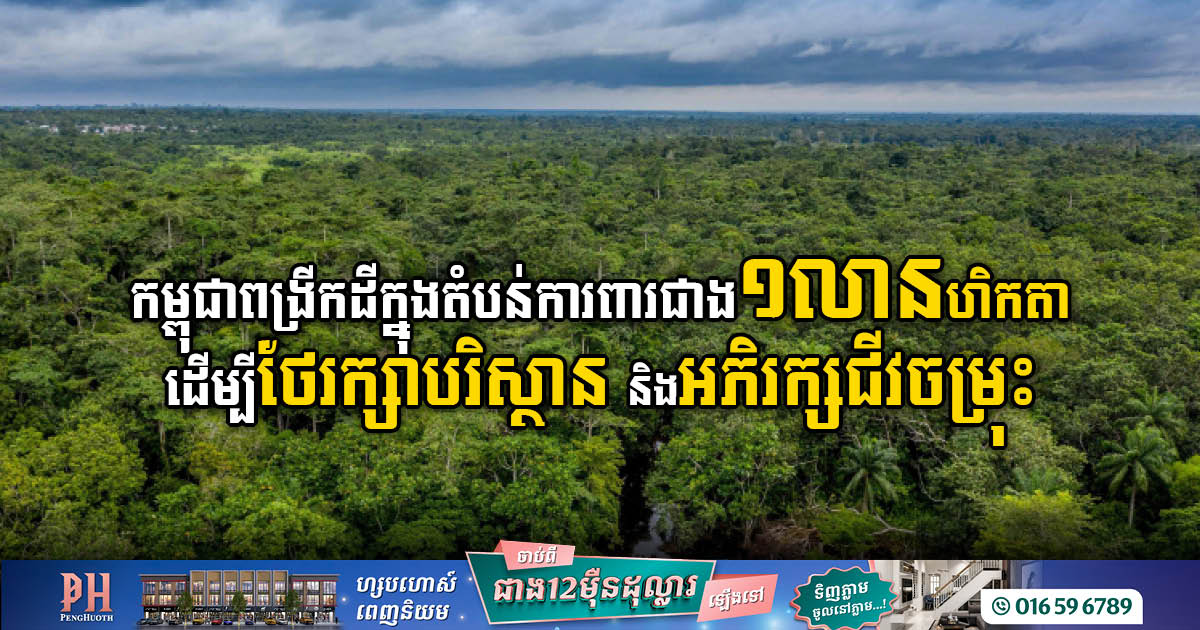ក្រសួងប្រកាសផ្តល់បណ្ណកម្មសិទ្ធដែលទទួលបានការលើកលែងពន្ធចំនួន ៨០ម៉ឺនក្បាលដី ជូនប្រជាពលរដ្ឋ
ក្រសួងរៀបចំដែនដី នគរូបនីយកម្ម និងសំណង់ តាមរយៈរដ្ឋបាលរាជធានី-ខេត្ត និងមន្ទីររៀបចំដែនដី នគរូបនីយកម្ម សំណង់ និងសុរិយោដី នឹងចាប់ផ្តើមប្រគល់បណ្ណកម្មសិទ្ធដែលទទួលបានការលើកលែងពន្ធប្រថាប់ត្រា (ពន្ធសូន្យ) ប្រមាណ ៨០ម៉ឺនក្បាលដី ជូនប្រជាពលរដ្ឋ។ នេះបើតាមកិច្ចប្រជុំពិភាក្សាការងាររវាងអង្គភាពសារពើពន្ធ និងអង្គភាពរដ្ឋបាលសុរិយោដី នៅថ្ងៃទី២៧ ខែឧសភា ឆ្នាំ២០២៥។ ថ្លែងក្នុងកិច្ចប្រជុំខាងលើ ឯកឧត្តមរដ្ឋមន្ត្រី សាយ សំអាល់ បានគូសបញ្ជាក់ថា ក្រសួងរៀបចំដែនដី នគរូបនីយកម្ម និងសំណង់ និងអគ្គនាយកដ្ឋានពន្ធដារ បានចាប់ផ្តើមចែករំលែកទិន្នន័យព័ត៌មានទៅវិញទៅមក ដើម្បីបុព្វហេតុក្នុងការគ្រប់គ្រងចំណូលសារពើពន្ធរបស់រដ្ឋ។ ឯកឧត្តមរដ្ឋមន្ត្រី បានបន្ថែមថា បញ្ហាដីធ្លីគឺជាបញ្ហារ៉ាំរ៉ៃ និងអាចបង្កគ្រោះថ្នាក់ដល់សង្គមជាតិនាថ្ងៃខាងមុខ ដែលទាមទារឱ្យមានវិធានការដោះស្រាយអោយបានសមស្របត្រឹមត្រូវ។ ឯកឧត្តមបន្តថា រាជរដ្ឋាភិបាលកម្ពុជា បានប្រើប្រាស់យុទ្ធសាស្ត្រចុះបញ្ជីដីធ្លីបង្ហើយដោយប្រើប្រាស់កំលាំងសរុប ដើម្បីកាត់បន្ថយវិវាទក្នុងសង្គមជាតិ ខណៈបច្ចុប្បន្នការចុះបញ្ជីដីធ្លីនៅទូទាំងប្រទេស គឺនៅសល់ត្រឹមតែប្រមាណ ៣០ម៉ឺនក្បាលដីទៀតប៉ុណ្ណោះ ដែលនឹងត្រូវបញ្ចប់ជាស្ថាពរ ក្រៅពីនេះក៏នៅមានការចុះបញ្ជីដីរដ្ឋ និងដីឯកជនរបស់រដ្ឋផងដែរ។ ជាមួយគ្នានេះដែរ ក្នុងកិច្ចប្រជុំខាងលើនេះ ឯកឧត្តម គង់ វិបុល អគ្គនាយកនៃអគ្គនាយកដ្ឋានពន្ធដារ បានគាំទ្រចំពោះការសម្រួលនីតិវិធីដើម្បីដោះស្រាយបញ្ចប់បញ្ហាក្បាលដីជាប់ពន្ធសូន្យ ដោយត្រូវបញ្ជូនឯកសារមកខាងពន្ធដារ ដើម្បីសម្រួលបែបបទនិងផ្ទៀងផ្ទាត់ទិន្នន័យនានាជាដើម ការធ្វើបទបញ្ញត្តិដើម្បីគ្រប់គ្រងបុរី គឺជាកត្តាសំខាន់ងាយស្រួលក្នុងការគ្រប់គ្រងលើការបង់ពន្ធ។ […]
ក្រសួងដែនដីនឹងចុះបញ្ជីដីតំបន់៣ ក្នុងខេត្តទាំង៦ជំុំវិញបឹងទន្លេសាប ជាទ្រព្យសម្បត្តិរបស់រដ្ឋ
រដ្ឋាភិបាល តាមរយៈក្រសួងរៀបចំដែនដី នគរូបនីយកម្ម និងសំណង់ ក្រសួងធនធានទឹក និងឧតុនិយម និងអាជ្ញាធរទន្លេសាប បានបើកកិច្ចប្រជុំរួមគ្នាមួយ ដើម្បីពិភាក្សាពីគម្រោងចុះបញ្ជីដីតំបន់៣ នៃដែនព្រៃលិចទឹកនៅក្នុងខេត្តទាំង៦ ជុំវិញបឹងទន្លេសាបជាទ្រព្យសម្បត្តិសាធារណៈរបស់រដ្ឋនាពេលខាងមុខនេះ។ កិច្ចប្រជុំនេះ ត្រូវបានធ្វើឡើងនៅថ្ងៃទី២៦ ខែឧសភា ឆ្នាំ២០២៥ ដឹកនាំដោយឯកឧត្តម សាយ សំអាល់ ឧបនាយករដ្ឋមន្ត្រី រដ្ឋមន្ត្រីក្រសួងរៀបចំដែនដី នគរូបនីយកម្ម និងសំណង់ និងជាប្រធានគណៈកម្មការចំពោះកិច្ចចុះបញ្ជីដីតំបន់ទន្លេសាប ព្រមទាំងមានការចូលរួមពីឯកឧត្តម ថោ ជេដ្ឋា រដ្ឋមន្ត្រីក្រសួងធនធានទឹក និងឧតុនិយម និងជាប្រធានអាជ្ញាធរទន្លេសាប។តាមរយៈកិច្ចប្រជុំខាងលើ បានឱ្យដឹងថា តំបន់ជុំវិញបឹងទន្លេសាបគ្របដណ្តប់ក្នុងខេត្តចំនួន៦ រួមមានខេត្តកំពង់ឆ្នាំង ខេត្តពោធិ៍សាត់ ខេត្តបាត់ដំបង ខេត្តបន្ទាយមានជ័យ ខេត្តសៀមរាប ខេត្តកំពង់ធំ ដែលត្រូវបានបែងចែកជាបីតំបន់ ក្នុងនោះតំបន់១ ជាតំបន់លំនៅដ្ឋាន និងស្រែចំការរបស់ប្រជាពលរដ្ឋ ដែលទទួលបានកម្មសិទ្ធិស្របច្បាប់ ហើយតំបន់២ ជាតំបន់ប្រើប្រាស់អាស្រ័យផល និងរក្សាទុកជាតំបន់ទ្រនាប់ការពារ ជាតំបន់ប្រជាពលរដ្ឋធ្វើស្រែឡើងទឹក និងប្រដេញទឹក និង តំបន់៣ ជាតំបន់ដែនព្រៃលិចទឹក ហាមឃាត់ដាច់ខាត។ ក្រោយពីពិនិត្យឡើងវិញ និងចុះផ្ទៀងផ្ទាត់ ឃើញថា បច្ចុប្បន្នតំបន់ទាំងបីនៅជុំវិញបឹងទន្លេសាបមានទំហំផ្ទៃដីដូចតទៅ៖ […]
ការងារវាស់វែងដីធ្លីក្នុងខេត្តឧត្ដរមានជ័យ បិទបញ្ចប់ទៅដោយជោគជ័យ
ក្រសួងដែនរៀបចំដែនដី បានប្រកាសបិទបញ្ចប់ដោយជោគជ័យលើការងាវាស់វែងដីធី្លមានលក្ខណៈជាប្រព័ន្ធ ក្នុងខេត្តឧត្ដរមានជ័យ។ ពិធីបិទបញ្ជប់នេះត្រូវបានរៀបចំឡើង ក្រោមអធិបតីភាពរបស់ឯកឧត្ដម សាយ សំអាល់ ឧបនាយករដ្ឋមន្រ្ដី រដ្ឋមន្រ្ដី ក្រសួងរៀបចំដែនដី នគរូបនីយកម្ម និងសំណង់ នៅថ្ងៃទី១៩ ខែឧសភា ឆ្នាំ២០២៥។ នាឱកាសនោះ ឯកឧត្ដម សាយ សំអាល់ បានថ្លែងអំណរគុណដល់មន្រ្តីពាក់ព័ន្ធ និងរដ្ឋបាលខេត្តឧត្តរមានជ័យ ដែលបានចូលរួមសម្រចយុទ្ធនាការចុះបញ្ជីដីធ្លីបង្ហើយ រហូតឈានមកទទួលបានវិញ្ញាបនបត្រសម្គាល់ម្ចាស់អចលនវត្ថុនៅនាពេលនេះ។ ឯកឧត្តមបន្ថែមថា ការចុះបញ្ជីដីបង្ហើយ គឺដើម្បីធានាបាននូវសុវត្ថិភាពផ្លូវច្បាប់ក្នុងការកាន់កាប់អចលនទ្រព្យ បង្កើតនិងបង្កើនបរិយាកាសគ្មានវិវាទ ផ្តល់សេវាគាប់ចិត្តជូនប្រជាជន និងបង្កើនចំណូលថវិកាជាតិ។ ទន្ទឹមគ្នានេះ ឯកឧត្តម ក៏បានជំរុញឲ្យអាជ្ញាធរមូលដ្ឋាន និងមន្ទីរពាក់ព័ន្ធផ្តល់អាទិភាពដល់ការរៀបចំទីក្រុង និងការពិនិត្យឈ្មោះ និងកូដភូមិសាស្ត្រ។ ចំណុចទាំងអស់នេះមានសារៈសំខាន់ខ្លាំងណាស់សម្រាប់ប្រព័ន្ធដោះស្រាយ និងការរៀបចំព្រំដែនឱ្យកាន់តែប្រសើរឡើងនៅទូទាំងភូមិ ឃុំ និងខេត្តទូទាំងប្រទេស។ លើសពីនេះ ឯកឧត្តម ក៏បានក្រើនរំឭកដល់ប្រជាពលរដ្ឋឲ្យថែរក្សាឲ្យបានត្រឹមត្រូវចំពោះវិញ្ញាបនបត្រកម្មសិទ្ធិដែលពួកគេបានទទួលផងដែរ។ ក្នុងពិធីប្រកាសបិទបញ្ចប់ការវាស់វែងក្បាលដីនេះដែរ ឯកឧត្តម សាយ សំអាល់ ក៏បានប្រគល់វិញ្ញាបនបត្រសម្គាល់ម្ចាស់អចលនវត្ថុចំនួន ៩៨០៣បណ្ណ ជូនបងប្អូនប្រជាពលរដ្ឋក្នុងស្រុកចំនួន ៣ នៃខេត្តឧត្ដរមានជ័យ រួមមានក្រុងសំរោង ស្រុកអន្លង់វែង និងស្រុកចុងកាល់។ កន្លងមក […]
រដ្ឋសម្រេចកាត់ដីរាជធានីភ្នំពេញទំហំជិត ២៣០ហិកតា ទៅឱ្យអាជ្ញាធរខេត្ដកណ្ដាលគ្រប់គ្រង
ក្នុងចំណាត់ការរដ្ឋបាលដ៏សំខាន់មួយ រាជរដ្ឋាភិបាលកម្ពុជាបានប្រកាសពីផែនការកាត់ផ្ទៃដីទំហំជិត ២៣០ហិកតា ចេញពីរាជធានីភ្នំពេញ ទៅឲ្យអាជ្ញាធរខេត្តកណ្តាលគ្រប់គ្រងវិញ។ សេចក្តីសម្រេចនេះ ធ្វើឡើងជាផ្លូវការក្នុងព្រះរាជក្រឹត្យដែលបានចុះហត្ថលេខាដោយប្រមុខរដ្ឋស្តីទី សម្តេចតេជោ ហ៊ុន សែន កាលពីថ្ងៃទី១៣ ខែមីនា ឆ្នាំ២០២៥ កែសម្រួលព្រំដែនរដ្ឋបាលរវាងតំបន់ទាំងពីរ។ ក្នុងព្រះរាជក្រឹត្យនោះសរសេរខ្លឹមសារនៅដូច្នេះថា៖ «ត្រូវបានកែសម្រួលព្រំប្រទល់រដ្ឋបាលរវាងរាជធានីភ្នំពេញ និងខេត្តកណ្តាល ដោយកាត់យកផ្ទៃដីទំហំ ២២៦ហិកតា ១៩៤០ម៉ែត្រការ៉េ (ដីគោកទំហំ ១៨១ហិកតា ៥០១៤ម៉ែត្រការ៉េ និងថ្ងៃទឹកទំហំ ៤៤ហិកតា ៦៩២៦ម៉ែត្រការ៉េ) ពីភូមិជ្រោយអំពិល១ សង្កាត់ក្បាលកោះ ខណ្ឌច្បារអំពៅ រាជធានីភ្នំពេញ មកឱ្យស្ថិតក្រោម ការគ្រប់គ្រងរបស់ភូមិកោះប្រាក់ ឃុំភូមិធំ ស្រុកកៀនស្វាយ ខេត្តកណ្តាល»។ ផ្អែកតាមការកែសម្រួលនេះ ព្រំប្រទល់រដ្ឋបាលរវាងរាជធានីភ្នំពេញ និងខេត្តកណ្តាល ត្រូវបានកំណត់ ដូចមានក្នុងផែនទីជាឧបសម្ព័ន្ធនៃព្រះរាជក្រឹត្យនេះ។ បទប្បញ្ញត្តិទាំងឡាយណាដែលផ្ទុយនឹងព្រះរាជក្រឹត្យនេះ ត្រូវទុកជានិរាករណ៍។ តាមរយៈព្រះរាជក្រឹត្យខាងលើ ប្រមុខរដ្ឋស្តីទី ក៏បានណែនាំឱ្យសម្តេចធិបតី ហ៊ុន ម៉ាណែត នាយករដ្ឋមន្ត្រីនៃព្រះរាជាណាចក្រកម្ពុជា ត្រូវទទួលបន្ទុក អនុវត្តព្រះរាជក្រឹត្យនេះចាប់ពីថ្ងៃឡាយព្រះហស្ថលេខាតទៅផងដែរ៕ គួររំលឹកថា កាលពីកន្លងមករាជរដ្ឋាភិបាលធ្លាប់បានធ្វើការកាត់យកផ្ទៃដីទំហំ ៣០២ហិកតា ពីក្រុងតាខ្មៅនៃខេត្តកណ្ដាល ឱ្យទៅជាផ្នែកមួយនៃខណ្ឌដង្កោ […]
រដ្ឋសម្រេចដាំដើមរាំងទឹកធ្វើជាក្រវាត់ព្រំនៅជុំវិញបឹងទន្លេសាបក្នុងតំបន់៣
រាជរដ្ឋាភិបាល ឯកភាពជាគោលការណ៍ជូនក្រសួងធនធានទឹក និងឧតុនិយម សហការជាមួយក្រសួង ស្ថាប័នជំនាញពាក់ព័ន្ធ អាជ្ញាធរដែនដីនៃខេត្តទាំង ៦ និងសហគមន៍ស្ថិតនៅជុំវិញតំបន់បឹងទន្លេសាប ធ្វើការដាំព្រៃលិចទឹកប្រភេទដើមរាំងទឹកធំៗ ធ្វើជាខ្សែក្រវាត់ព្រំបន្ថែមនៅតាមចន្លោះបង្គោលព្រំតំបន់៣ ដែលបានសាងសង់រួច ក្នុងខេត្តទាំង៦ ជុំវិញបឹងទន្លេសាប។ នេះបើតាមលិខិតលេខ ៦៩៦ សជណ.កធ ចុះថ្ងៃទី២៥ ខែមេសា ឆ្នាំ២០២៥ របស់ទីស្តីការគណៈរដ្ឋមន្ត្រី។ បន្ថែមពីនេះ រាជរដ្ឋាភិបាល ឯកភាពឱ្យធ្វើការដាំស្តារព្រៃលិចទឹកឡើងវិញ នៅតាមទីតាំងដែលរងនូវការទន្ទ្រាននាពេលកន្លងមក និងតំបន់ដែលរេចរឹលក្នុងខេត្តទាំង៦ ជុំវិញបឹងទន្លេសាប។ ទន្ទឹមនឹងនេះ រាជរដ្ឋាភិបាល ឯកភាពធ្វើការសិក្សាពីសក្តានុពល និងលទ្ធភាពរបស់បណ្តាស្ទឹងសំខាន់ៗទាំង១១ នៅជុំវិញតំបន់បឹងទន្លេសាប ដែលជាប្រភពទឹកមួយដ៏សំខាន់ហូរចូលទៅបឹងទន្លេសាប សម្រាប់ផ្គត់ផ្គង់ទឹកប្រើប្រាស់ ស្រោចស្រព ចិញ្ចឹមជីវៈចម្រុះ និងផ្តល់លំនឹងដល់ប្រព័ន្ធអេកូឡូស៊ីរបស់បឹងទន្លេសាប។ លើសពីនេះ រាជរដ្ឋាភិបាល ក៏បានឯកភាពធ្វើការសិក្សាពីសណ្ឋានបាតបឹងទន្លេសាប ដើម្បីធ្វើការវិភាគលើបម្រែបម្រួលស្ថានភាពសមាសភាគ ដីបាតបឹង គុណភាពទឹក សារធាតុកខ្វក់ បរិមាណទឹក កម្ពស់ទឹក អេកូឡូស៊ីនៃបឹង ក្នុងការធានាឱ្យបាននូវសន្តិសុខ ទឹក និងសន្តិសុខស្បៀងនៅក្នុងតំបន់។ គួរបញ្ជាក់ថា ការងារសាងសង់បង្គោលព្រំនៅតំបន់៣ ជុំវិញបឹងទន្លេសាប សម្រេចបាន ១០០% នៃចំនួនបង្គោលសរុបចំនួន […]
មកទល់ពេលនេះ រដ្ឋាភិបាលកម្ពុជាបញ្ចប់ការវាស់វែងដីធ្លីលក្ខណៈជាប្រព័ន្ធបាន ៩ខេត្តហើយ
ក្រសួងរៀបចំដែនដី នគរូបនីយកម្ម និងសំណង់ (ដ.ន.ស.) បានឱ្យដឹងថា មកទល់ពេលនេះ មានខេត្តចំនួន ៩ ដែលបានបញ្ចប់ការវាស់វែងដីធ្លីមានលក្ខណៈជាប្រព័ន្ធ ខណៈរាជធានី-ខេត្ត ១៦ផ្សេងទៀត គ្រោងបញ្ចប់ឆាប់ៗនេះ។ ខេត្តទាំង ០៩នោះ រួមមាន ខេត្តកំពង់ចាម ខេត្តស្វាយរៀង ខេត្តសៀមរាប ខេត្តកំពង់ស្ពឺ ខេត្តតាកែវ ខេត្តមណ្ឌលគិរី ខេត្តកែប ខេត្តព្រះសីហនុ និងខេត្តកណ្តាល។ បន្ថែមពីនេះ ខេត្តចំនួន ៤ ក្នុងចំណោម ខេត្តទាំង ០៩ខាងលើ រួមមាន ខេត្តកំពង់ចាម ខេត្តស្វាយរៀង ខេត្តសៀមរាប និងខេត្តកំពង់ស្ពឺ ត្រូវបានរៀបចំពិធីប្រកាសបិទបញ្ចប់ការងារវាស់វែងដីធ្លីមានលក្ខណៈជាប្រព័ន្ធជាផ្លូវការរួចរាល់ហើយដែរ។ ជាក់ស្តែងថ្មីៗនេះ រាជរដ្ឋាភិបាលកម្ពុជា ទើបបានប្រកាសពីការបិទបញ្ចប់ការវាស់វែងដីធ្លីមានលក្ខណៈជាប្រព័ន្ធក្នុងខេត្តកំពង់ស្ពឺ ខណៈបានវាស់វែងក្បាលដីសរុបចំនួន ១.០៨៨.០៩៥ក្បាលដី។ (អានបន្ថែម) ដោយឡែក រាជធានី-ខេត្តចំនួន ១៦ ទៀត ក៏នឹងបញ្ចប់ការវាស់វែងដីធ្លីមានលក្ខណៈជាប្រព័ន្ធជាបន្តបន្ទាប់ នាពេលខាងមុខ យ៉ាងយូរត្រឹមដំណាច់ខែឧសភា ឆ្នាំ២០២៥ នេះ ហើយការចុះបញ្ជីនិងការផ្តល់វិញ្ញាបនបត្រសម្គាល់ ម្ចាស់អចលនវត្ថុជូនប្រជាពលរដ្ឋ បាននិងកំពុងដំណើរការជាបន្តបន្ទាប់ស្របតាមនីតិវិធី។ ទន្ទឹមនឹងនេះ […]



 English
English







